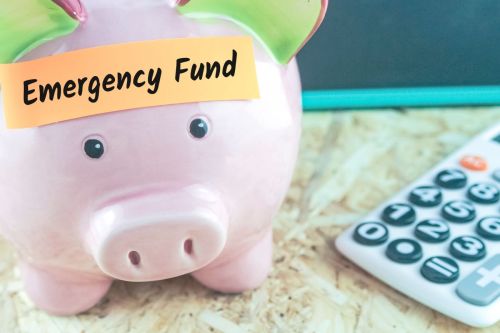We all want to be optimistic about the future and avoid thinking about bad things that might happen, like losing a job, a sick pet, or the car breaking down. But when it comes to managing money, most of us know the financially savvy thing to do is to plan for possible setbacks, so you’re covered if the unexpected does occur.
That’s where an emergency fund comes in.
Explaining emergency funds to kids and teens doesn’t have to be all doom and gloom—it’s more about smart planning strategies to help them build a financial cushion. Here we help you start the conversation by breaking down what an emergency fund is, why tweens and teens should start building one now, how much an emergency fund should be, and the easiest steps to get started.
Key takeaways
- An emergency fund, also known as a rainy-day fund, are savings used to cover unexpected and urgent expenses, like a flat tire.
- Emergency funds act as a financial safety net, so people don’t need to pull from their savings or go into credit card debt if they need money to handle something unexpected.
- Emergency funds should be in a savings account separate from your everyday spending, but still easy enough to withdraw from without fees.
- An emergency fund is there to cover emergencies—not parties, vacations, or new wardrobes. Use separate savings to cover those costs.
- Most people should aim to save three to six months’ worth of essential living expenses in an emergency fund.

What is an emergency fund?
An emergency fund in Canada, sometimes also called a rainy-day fund, is a savings account designed to help cover the costs of unforeseen circumstances, a.k.a. an emergency. This is money that should be easily accessible, so it shouldn’t be tied up with investments or kept where it could be difficult to withdraw quickly.
Ideally, emergency funds should be quick to access because they’re intended for sticky and often urgent situations, like unexpected medical expenses, or if your vehicle breaks down and needs to be repaired. It’s not really possible to save up for an emergency after the fact (hence, its name!).
Read more about common financial literacy terms for teens.
Why should you have an emergency fund?
Everyone, even teens, should try to have an emergency fund. Even putting aside a modest amount could help prevent financial problems down the road if you need to cover unexpected costs—tomorrow, next month, or a few years from now. That includes losing a job, replacing a cellphone that was dropped into water, or an expensive root canal at the dentist—these are all expenses that could easily land them into debt one day.
Without an emergency fund, your teen might be left with some uncomfortable financial options. For instance, pulling money out of savings, or racking up high interest debt via credit cards or high-interest payday loans to handle the costs. (And, parents, it’s good to remind your kids that you’re not the emergency fund, either!) Repaying debt can take a long time, especially when your teen is paying interest on top of the initial loan they needed to pay for an emergency. Even if an emergency fund is minimal, having something in place helps soften the blow of unexpected costs with less money borrowed—and less to pay back.
Remember, emergency funds are for emergencies. Even when life wears out your teen, and they’re convinced a vacation, some new clothes, or adopting a new pet feels like an emergency, these nice-to-haves should be paid for with separate savings. Emergency funds also shouldn’t be used for big events, like birthday parties or taking a trip during a gap year. None of these examples are unexpected, necessary, or urgent events, so instead, teens should plan ahead to cover these costs. Saving for these things, plus an emergency fund, may seem insurmountable at first, but there are a few ways to get it all done.
How much should you have in an emergency fund?
If your kids immediately ask, “How much should I have in an emergency fund?” the honest answer is, “It depends.” After all, it’s difficult to predict what emergency could arise or how long it could go on.
That being said, the conventional wisdom is that we should each aim to save three to six months of essential living expenses; some experts even recommend eight months. This means saving up to cover things like rent, bills, and food they might need for three to six months. Entertainment costs aren’t factored in here, since an evening at the movies or a road trip to blow off steam aren’t considered essential expenses. Emergency savings are to get you through a tough period—period.
How much an emergency fund should be when it comes to hard numbers will vary depending on the cost of living in your city or town. But, if a three- to six-month emergency fund sounds overwhelming to your teen, then suggest they start small and build the savings as time goes on. A couple of hundred dollars in an emergency fund is much better than nothing.
For extra motivation, kids might want to gamify an emergency savings goal by using challenges, competitions, and rewards as motivation for saving. Who doesn’t love a gold star for their financial efforts?
Steps to building an emergency fund
Just like any other savings goal, creating an emergency fund starts with knowing how much you want, then figuring out how to build up to that dollar value. Teens can follow these steps to get started:
1. Determine how much you need
As mentioned, the general rule of thumb for an emergency fund is three to six months of essential living expenses. But it’s always better to start small—it might be more manageable to aim for one or three months first, then reassess once they’ve hit that goal.
To figure out how much exactly they’ll need for emergency savings, make a list of all essential expenses. While for adults that usually includes mortgage payments or rent, as well as bills, these costs will likely be different for teens. Items they should account for include:
- Transit or car payments—plus gas and parking
- Auto insurance payments
- Any dental and/or medical costs, such as therapy
- Phone and/or internet
- Food
- Costs related to post-secondary education

They should calculate how much they spend on each essential item per month to come up with a monthly grand total. If the aim is a three-month emergency fund, for example, multiply that one month number by three. Now you have an emergency savings goal to work toward.
Note: Recurring fees such as streaming services, monthly subscriptions, or apps that aren’t considered essential might need to be paused for a few months. Have your teen take stock of what they could do without to avoid spending needlessly when times are tight.
2. Build savings into your budget
Now that your kid has a number to work toward, get them to take a look at their budget to see how much they can reasonably save toward an emergency fund each month. The easiest way is to start with their average monthly income, then list all the things that come out of their account, for example:
- Expenses such as food and bills, gas or transit pass, plus the fun stuff, like concerts, gaming, clothes, and takeout
- Any debt repayment plans
- Other savings and investments
By calculating income minus expenses, your teen should know exactly how much they have to put toward an emergency fund each month.
If they can only start with a small amount, that’s fine! It is always better to start saving sooner than later. The first goal is to just get started.
Tip: Our savings calculator can help teens determine how much they can afford to save each week!
3. Open an emergency-specific savings account and automate your savings
Be strategic about where you put your emergency savings fund. One of the easiest ways your teen can do that is to move money to a separate account from the one they use on a daily basis. Look for the following features in an emergency fund account:
- Zero low-transaction fees, meaning they won’t be penalized for not using the account
- Penalty-free withdrawals
- The ability to earn interest
To make saving easier, automate it wherever possible. For instance, if your teen is paid biweekly and knows how much money they want to put toward their emergency fund, set up an automatic transfer. That way, the bank can pull that money on the day they get paid, or the day after. It’s one less task they’ll need to worry about, plus the money gets squirrelled away before they’ve had a chance to spend it.
4. Track spending to find extra dollars for an emergency fund
If your teen isn’t making headway on an emergency fund, you might want to suggest they track where all their money is going. They should look at their banking statements each month to see where they might be able to cut out unnecessary spending. For instance, do they order takeout more often than they realize, or spend more on online games than they’ll admit? Anywhere they can reduce spending, even by a few dollars, can help funnel extra money into a rainy-day fund.
There might be other times throughout the year when your teen can add extra money to their savings, too. For instance, many people get a tax refund around tax time. Instead of blowing it all on a night out, they could reserve some of this money for the emergency fund. Or, if birthdays or holidays means an infusion of cash from family members, they could put some away. By planning wisely, they’re much more likely to have an emergency fund built up in no time. And with smart saving strategies in place, once they’ve hit that emergency fund goal, why not effortlessly save up for something fun?

Start saving for a rainy day
Learning how to create an emergency fund is an important part of financial literacy. Parents, you can lead by example by teaching kids about your own emergency fund and any struggles you might have had to build up one—or better yet, tell them about a time an emergency fund got the family out of a tight situation.
There’s no need to catastrophize, but informing kids about the real possibility of needing their own emergency fund one day will help prepare them to be money-smart adults. Then, walk through the steps of how to start one together. Mydoh can help by making it easy for kids to learn about money. And with the Mydoh Smart Cash Card, teens and tweens get used to managing their spending while also saving toward a goal—emergency funds or otherwise—all under your supervision, so you can help them build a foundation of financial literacy.
Download Mydoh to help build the foundation of financial literacy for your kids and teenagers.
This article offers general information only and is not intended as legal, financial or other professional advice. A professional advisor should be consulted regarding your specific situation. While the information presented is believed to be factual and current, its accuracy is not guaranteed and it should not be regarded as a complete analysis of the subjects discussed. All expressions of opinion reflect the judgment of the author(s) as of the date of publication and are subject to change. No endorsement of any third parties or their advice, opinions, information, products or services is expressly given or implied by Royal Bank of Canada or its affiliates.

















